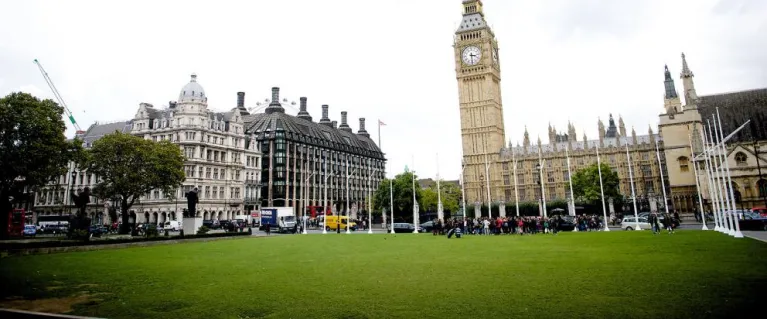
Parliament Square Garden
Parliament Square Garden is an area of significant historic and symbolic value. Find out about its history and the history of its statues.
Visiting the Square
To find out how to get to Parliament Square Garden, as well as what facilities are available, please go to our visiting page.
For further information, go to Visit London or the UNESCO site.
Horticultural works (September 2025)
Fencing has temporarily been installed at Parliament Square to protect the grass and public safety whilst horticultural works are undertaken, the hard standing areas remain open and accessible. Thank you for your understanding.
History of Parliament Square Garden
End of the 10th Century
There was a small monastery on Thorney Island, near the site of the current Abbey.
Early 1780s
The churchyard and streets adjoining St Margaret’s Church were demolished, the churchyard cleared and a lawn was sown.
1834
A fire virtually destroyed the medieval Westminster Palace.
1852
A new palace (now known as the Houses of Parliament) was completed, after Sir Charles Barry won a competition to design it.
1858
The Clock Tower (Big Ben) was completed.
1868
Parliament Square Garden was included within Barry's designs, with the aim of providing the new Houses of Parliament with a better setting.
WWII
The Westminster area suffered significant bomb damage. In 1948 the architect Grey Wornum was commissioned to redesign the square as one central garden island for the then Ministry of Transport. The design now comprises a square lawn, paved walkways and formal paths, with seats on the northern and western edges.
1987
The Houses of Parliament and Westminster Abbey (including St Margaret's Church) were inscribed on the UNESCO list of World Heritage Site. They are recognised internationally as buildings of outstanding architectural importance, and as symbols of spiritual and democratic ideals.
1987
It was designated as the Westminster Abbey and Parliament Square Conservation Area.
1996
Parliament Square Garden became an English Heritage Grade II Registered Garden of Special Historic Interest.
Parliament Square Garden today
We have been responsible for the garden since 2002. It plays an important role in our heritage, as a place of ceremonies and significant historic events. It is part of the ceremonial route between Westminster Abbey and Westminster Hall.
Sir Winston Churchill
Bronze statue by sculptor Ivor Roberts-Jones, standing on a granite pedestal in the north-east corner of the square.
- Date of monument: 1973
- Materials: pale grey granite and bronze
- Statutory status: Listed Grade II
David Lloyd George
Bronze statue by sculptor Glynn Williams, standing on a Welsh slate pedestal on the north side of the square, between the monuments to Sir Winston Churchill and Field Marshal Jan Christian Smuts.
- Date of monument: 2007
- Materials: Welsh slate and bronze
- Statutory status: not listed
Field Marshal Jan Christian Smuts
Bronze statue by sculptor Jacob Epstein, standing on a granite pedestal near the north-west corner of the square.
- Date of monument: 1956
- Materials: South African grey granite and bronze
- Statutory status: Listed Grade II
Viscount Palmerston
Bronze statue by sculptor Thomas Woolner, standing on a granite pedestal near the north-west corner of the square.
- Date of monument: 1876
- Materials: Mottled grey/pink Westmoreland granite and bronze
- Statutory status: Listed Grade II
Edward Stanley, Earl of Derby
Bronze statue by sculptor Matthew Noble, standing on a granite pedestal (with bronze reliefs by sculptor Horace Montford) at the north end of the west side of the square.
- Date of monument: 1874
- Materials: Pink granite and bronze
- Statutory status: Listed Grade II
Benjamin Disraeli, Earl of Beaconsfield
Bronze statue by sculptor Mario Raggi, standing on a granite pedestal on the west side of the square, between the monuments to The Earl of Derby and Sir Robert Peel.
- Date of monument: 1883
- Materials: Pink Peterhead granite and bronze
- Statutory status: Listed Grade II
Sir Robert Peel
Bronze statue by sculptor Matthew Noble, standing on a granite pedestal at the south end of the west side of the square.
- Date of monument: 1876
- Materials: Pink granite and bronze
- Statutory status: Listed Grade II
Nelson Mandela
Bronze statue by sculptor Ian Walters, standing on a low Portland stone base, forward of the monument to the Sir Robert Peel, in the south-west corner of the square. Near the centre of the west side of the square.
- Date of monument: 2007
- Materials: Portland stone and bronze
- Statutory status: not listed
Mahatma Gandhi
Bronze statue by sculptor Philip Jackson, standing on a low Portland stone base, forward of the monument to Benjamin Disraeli, Earl of Beaconsfield, near the centre of the west side of the square.
- Date of monument: 2015
- Materials: Portland stone and bronze
- Statutory status: not listed
Millicent Fawcett
The bronze statue portrays Dame Millicent Fawcett at the age of 50, when she became president of the National Union of Women's Suffrage Societies. On the statue's base are portraits of 50 women and a small number of men, who made significant contribution to the advancement of women's rights.
- Date of monument: 2018
- Materials: bronze
- Statutory status: not listed
Events
If you wish to hold an event at Parliament Square Garden this must be arranged through us. Please go to our booking page for more information.
Need a document on this page in an accessible format?
If you use assistive technology (such as a screen reader) and need a version of a PDF or other document on this page in a more accessible format, please get in touch via our online form and tell us which format you need.
It will also help us if you tell us which assistive technology you use. We’ll consider your request and get back to you in 5 working days.